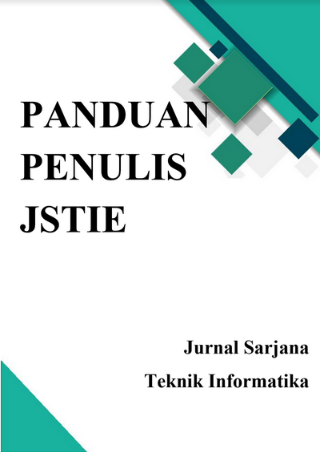IMPLEMENTASI PROXY SERVER DAN LOAD BALANCING MENGGUNAKAN METODE PER CONNECTION CLASSIFIER (PCC) BERBASIS MIKROTIK (Studi kasus : Shmily.net)
DOI:
https://doi.org/10.12928/jstie.v2i2.2729Abstract
       Jaringan Internet sudah merupakan suatu kebutuhan untuk setiap Negara berkembang, semua itu terkendala ketika bermasalah pada suatu jaringan Internet seperti link disconect maupun down hingga terputusnya jaringan Internet. Permasalahan tersebut akan menjadi suatu hal yang sangat menyusahkan bagi pengguna Internet ketika pengguna sedang dalam keadaan penting atau pada jam-jam kerja yang sangat tergantung pada koneksi Internet dan kemudian koneksi terputus.
Pengembangan proxy server dan load balancing dilakukan tahapan penelitian yang terdiri dari analisa sistem dilanjutkan dengan perancangan sistem yang meliputi perancangan topologi, perancangan server, dan perancangan sistem kemudian pengujian penelitian digunakan uji validasi oleh user Shmily.net.
           Berdasarkan hasil pengujian proxy dan load balancing memperlihatkan bahwa kedua koneksi yang berasal dari dua ISP Speedy dapat berjalan secara bersamaan dan akan otomatis berganti ketika salah satu koneksi terputus dan berjalan normal secara bersamaan ketika kedua koneksi tidak bermasalah. Berdasarkan hasil penelitian dapat disimpulkan bahwa sistem load balancing dan proxy server merupakan solusi untuk kebutuhan Internet secara real time.
Kata Kunci : Jaringan, Ubuntu, Proxy, Mikrotik, load balancingReferences
Bagja P., 2010, Konfigurasi load balancing pada sistem jaringan komputer di Balai Besar , Teknik Informatika Universitas Komputer Indonesia Bandung.
Rakhman A., 2011, Membangun Sistem VRRP Menggunakan Sistem Operasi FreeBSD, Teknik Informatika Universitas Ahmad Dahlan Yogyakarta.
Irfan M., 2010, Penerapan Bandwidth Management menggunakan metode PCC (Per Connection Classifier) di PT. Neuronworks, Teknik Informatika Politeknik Bandung.
Manual book, 2010, Mikrotik Router OS.
Towidjojo R., 2013, Konsep dan Implementasi Routing dengan Router MikroTik – 200% Connected.
Hudson P., 2011, Ebook Ubuntu Unlieshed.
Downloads
Published
Issue
Section
License
License and Copyright Agreement
In submitting the manuscript to the journal, the authors certify that:
- They are authorized by their co-authors to enter into these arrangements.
- The work described has not been formally published before, except in the form of an abstract or as part of a published lecture, review, thesis, or overlay journal. Please also carefully read Journal Posting Your Article Policy.
- The work is not under consideration for publication elsewhere.
- The work has been approved by all the author(s) and by the responsible authorities – tacitly or explicitly – of the institutes where the work has been carried out.
- They secure the right to reproduce any material that has already been published or copyrighted elsewhere.
- They agree to the following license and copyright agreement.
Copyright
Authors who publish with Jurnal Sarjana Teknik Informatika agree to the following terms:
- Authors retain copyright and grant the journal right of first publication with the work simultaneously licensed under a Creative Commons Attribution License (CC BY-SA 4.0) that allows others to share the work with an acknowledgement of the work's authorship and initial publication in this journal.
- Authors are able to enter into separate, additional contractual arrangements for the non-exclusive distribution of the journal's published version of the work (e.g., post it to an institutional repository or publish it in a book), with an acknowledgement of its initial publication in this journal.
- Authors are permitted and encouraged to post their work online (e.g., in institutional repositories or on their website) prior to and during the submission process, as it can lead to productive exchanges, as well as earlier and greater citation of published work.







